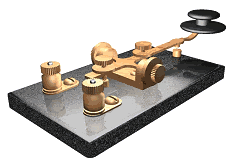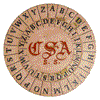|
GC1A7KF
 Sparky's History Lesson
Sparky's History LessonType: Mystery | Size: Small  | Difficulty:
| Difficulty:  | Terrain:
| Terrain:  By: *Sparky* @ | Hide Date: 03/26/2008 | Status: Available Country: United States | State: Colorado Coordinates: N39° 52.000 W104° 56.000 | Last updated: 08/30/2019 | Fav points: 1 

 Clue 1 Clue 1  Clue 2 Clue 2  The cache is not at the posted coordinates. You must solve the puzzle in order to find the actual coordinates.  One of the many ironies of the American Civil War was that a colleague of Major Albert J. Myer, detailed to assist him in perfecting his system to the satisfaction of the War Department just before the war, served the South. Edward Porter Alexander of Georgia was a West Point graduate military engineer. With the secession of his state, Alexander opted for the Southern cause and was charged by President Jefferson Davis with organizing a signal corps to serve Confederate forces facing Washington. With the advance of the Federal army toward Manassas (Bull Run), Virginia, in the spring of 1861, Alexander found himself on an elevation that afforded an excellent view of the developing battle. A chance glance revealed a critical enemy flanking movement that endangered his side. Grabbing a flag, he frantically waved to attract the attention of one of his trainees: “LOOK TO YOUR LEFT - YOU ARE TURNED.” The tactical warning, as well as demonstration of tactical communication, made quite an impression on generals of both sides. Myer subsequently used Alexander’s exploit to petition Congress to organize a signal corps for the North, even as his erstwhile student and colleague established the system in the South. Against this background of innovation, embryonic technology, and innocence, the Civil War stands as something of a watershed, and the seeds and sprouts of cryptology are evident at every turn. In 1862, the South adopted the centuries-old Vigenère as its principal official cipher. The South enciphered important messages with the Vigenère, then transmitted with a flag code that might or might not be “read” by the enemy. The North implemented the Myer system, later known as wig-wag, featured one flag or two torches for battlefield signaling. The flags come in three color schemes: a red square in the middle of a white background, white on black, or black on white. The flag that is used at any time depends on the visibility. The flags come in three sizes: two feet by two feet, four by four, and six by six. The 2x2 flags are used in battle to send messages back to headquarters and to send back commands, sometimes by more than one signaler. The 4x4 flags are used for almost everything else. The 6x6 flags are for sending messages that can't wait until night so they could use the torches. These flags are so heavy that no one really wanted to use them. One torch is put on a pole and waved around and is called the action torch. The other was stuck on a stake and called the foot torch. The purpose of the foot torch is to decipher if the message is meant for you or for the guy on the other side of the sender. The torches run on turpentine. Turpentine is used in the torches because it burns brighter than kerosene. People don't use turpentine in lamps because it is far too volatile to be used in that manner. The code uses three positions. Position one is to the left. Position two is to the right. Position three is forward. The systematizing of signals, using the bases of two elements, admits of such illimitable applications at once so much more simple and more numerous, than any other, that is seems best adapted to universal use. That signals could be made with two elements, has probably been known form very early antiquity by studies of the subject. The first systems recorded, seem to have been based upon this plan. To understand its practical use in the field, take an alphabet of two elements, devised by the given rule; as, for instance: A is one, one, or 1 1. (*) B is one, two, two, one, or 1 2 2 1. C is two, one, two or 2 1 2. D is one, one, one 1 1 1; and so on, combinations of "ones" and "twos." (*) Modified from 1864 manual which read "A is one, two, or 1 2". This was done within the manual in order to explain the how the system worked, without disclosing the actual code used.  I spent some time as a Civil War Reenactor in an Artillery Unit (Richmond Fayette Artillery) in California. Before I left a friend of mine and I set up a Signal Corps for our club. This puzzle is based on some of the cryptography and signaling I learned. And yes, this is where I got the name Sparky. This is my first Puzzle Cache I hope you enjoy it. Please bring your own GeoStick. Feel free to contact me for assistance. You can check your answers for this puzzle on Geochecker.com. nxfqn tbws kkvvv eppv gtosd qwv ldvl krwp egypg zyik getob koy isthv avvuv bwu expn eauj cteb lvb Additional Waypoints
Add cache to watch list Log your visit Picture Gallery
Puzzle: Crazy Bet. What are you doing? A hint for the hint: What kind of ink did she use. What sport/game is this we are all playing. Cache: It is NOT in the obvious place so please DON'T dig.
GC985R4 Mondo's Quacking Up #19 (2.50 kms N) GC985TY Are You Brave Enough? (3.24 kms N) GC85CHZ Mini Cachers 1st hide (7.43 kms SE) GC85CJ3 Rattlesnake hill (7.68 kms SE) GC2QZP4 April 1st~April Fools' Day (9.98 kms S) |
Driving Directions
10 Logs:
 Log Log
|
